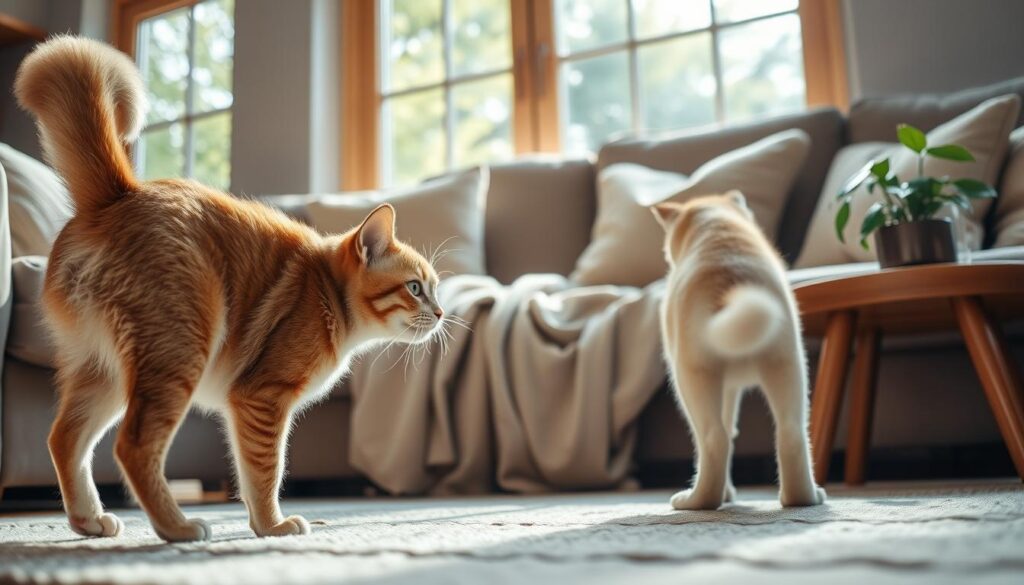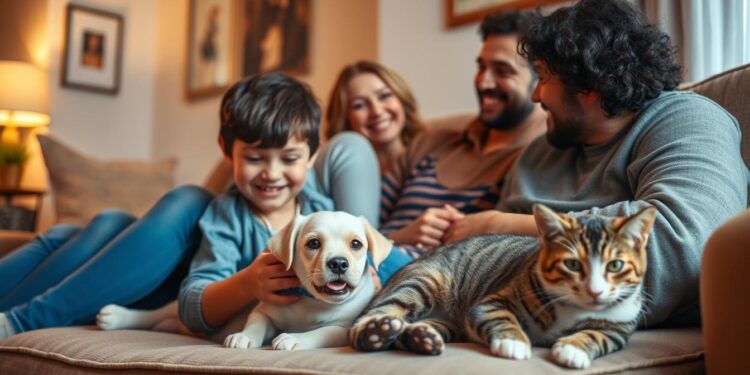For many pet owners, the debate between cats and dogs as preferred pets has been a longstanding one. However, what if you don’t have to choose? Many households have successfully integrated both into their families, enjoying the unique benefits of pet ownership.
Having multiple pets can bring numerous advantages, from companionship to improved mental health. By introducing a new pet to your household, you can create a harmonious and loving environment for all.
With the right approach, you can enjoy the best of both worlds, experiencing the joy and companionship that comes with sharing your life with multiple pets.
Cats or Dogs – How About Both?? The Benefits of a Multi-Pet Household
For many families, the decision to bring home a new pet often raises the question: cats or dogs, or why not both? Having multiple pets can bring numerous benefits, from companionship and social development to improved health and wellness for the whole family.
Complementary Companionship: Different Personality Benefits
One of the significant advantages of having both cats and dogs is the complementary companionship they can provide. Dogs are often social and require interaction, which can encourage their owners to engage in more physical activity and socialize with other pet owners. On the other hand, cats are generally more independent and can offer a calming presence. This mix of personalities can create a balanced and harmonious home environment, where both pets can thrive and provide companionship to each other and their owners.
Social Development: How Cats and Dogs Learn From Each Other
Growing up together, cats and dogs can learn from each other and develop social skills. For instance, a puppy and kitten introduced at a young age can learn to tolerate and even play with each other. This interaction can aid in their social development, helping them become more confident and calm in the presence of other animals. Moreover, this companionship can reduce the likelihood of behavioral problems, as the pets learn to entertain and comfort each other.
Health and Wellness Advantages for the Whole Family
Studies have shown that households with multiple pets can experience health and wellness benefits. The companionship between cats and dogs can lead to reduced stress levels for both pets and their owners. Furthermore, having multiple pets can encourage a more active lifestyle, as dogs require regular exercise, and playtime with cats can also contribute to physical activity. Proper pet care, including regular veterinary check-ups and a balanced diet, is essential to maintaining the health and wellness advantages of a multi-pet household. Adopting cats and dogs and providing them with a loving home not only enriches their lives but also contributes to a healthier family environment.
In conclusion, having both cats and dogs in the household can bring numerous benefits, from complementary companionship and social development to improved health and wellness. By understanding the needs of both pets and providing a nurturing environment, families can enjoy the rewards of a multi-pet household.
Successfully Introducing and Managing Your Furry Friends

The key to a peaceful coexistence between cats and dogs lies in a well-planned introduction. A successful introduction sets the tone for a harmonious multi-pet household.
First Impressions: Safe Introduction Techniques
When introducing cats and dogs, it’s crucial to do so in a controlled environment. Start by keeping the pets separated and allowing them to become familiar with each other’s scents and sounds. Gradual introduction is key to preventing initial conflicts.
Begin by letting them see each other from a distance, then gradually increase their interaction time under close supervision. Rewarding calm behavior with treats can also help create a positive atmosphere during their initial meetings.
Creating Harmony: Space Management and Territory Solutions
Managing space and territory is vital in a multi-pet household. Ensure that both cats and dogs have their own areas where they can retreat if needed. Providing multiple levels or rooms can help reduce competition and stress between pets.
For cats, this might mean having cat trees or shelves, while dogs might appreciate their own beds or crates. By giving each pet its own territory, you can minimize conflicts and create a more harmonious home.
Feeding Routines and Preventing Food Aggression
Establishing a consistent feeding routine is essential in a household with both cats and dogs. Feed them in separate areas to prevent food aggression and competition. Monitoring their behavior during meals can help identify any potential issues early on.
| Pet | Feeding Location | Feeding Time |
|---|---|---|
| Cat | Separate room or elevated area | Morning and evening |
| Dog | Designated dog feeding area | Morning and evening |
Managing the Budget: Cost-Effective Multi-Pet Ownership
Managing the costs associated with owning multiple pets requires some planning. Consider bulk purchases of pet food and supplies, and look into pet insurance options to help mitigate veterinary costs.
Creating a budget that accounts for the needs of both cats and dogs can help ensure that you provide the necessary care without financial strain. Prioritizing preventative care, such as regular check-ups and vaccinations, can also help reduce long-term costs.
Essential Care Tips for Your Cat and Dog Household

Creating a happy home for both cats and dogs involves more than just love; it requires a deep understanding of their individual needs. When you have multiple pets, ensuring their health and happiness can be challenging, but with the right approach, it can also be incredibly rewarding.
Species-Specific Needs: Exercise, Play, and Attention
Cats and dogs have different requirements when it comes to exercise, play, and attention. Dogs often need more exercise and training compared to cats, who are generally more sedentary. However, both need regular playtime to stay happy and healthy.
For dogs, this might mean daily walks and playtime in the yard, while cats benefit from interactive toys and climbing structures. Understanding these needs can help you create a more harmonious household.
Grooming and Hygiene Routines for Both Pets
Grooming is an essential part of pet care. Dogs often require regular baths and nail trimming, while cats are generally easier to groom, needing only occasional brushing and nail care.
Maintaining good hygiene practices, such as regular cleaning of food and water bowls and litter boxes, is crucial for the health of both pets. This not only keeps your pets healthy but also contributes to a cleaner and more pleasant home environment.
| Pet | Grooming Needs | Hygiene Practices |
|---|---|---|
| Dogs | Regular baths, nail trimming | Clean food/water bowls daily |
| Cats | Occasional brushing, nail care | Clean litter box regularly |
Veterinary Considerations and Preventative Healthcare
Regular veterinary check-ups are vital for both cats and dogs. Preventative healthcare measures, such as vaccinations and parasite control, help protect your pets from diseases.
Discussing nutrition with your vet can also provide insights into the best diet for your pets, ensuring they receive the necessary nutrients for optimal health. A balanced diet is a cornerstone of good health, and the right food can make a significant difference in their overall well-being.
By understanding and meeting the specific needs of your cats and dogs, you can create a happy, healthy environment for all your pets, making your home a wonderful place for them to thrive.
Conclusion: The Rewarding Journey of Cat and Dog Parenthood
Embracing a multi-pet household with both cats and dogs can be a highly rewarding experience. With the right approach, these mixed breed pets can live harmoniously, providing companionship and joy to the entire family.
As discussed, introducing cats and dogs to each other requires patience, understanding, and a well-planned strategy. By managing their space, feeding routines, and providing species-specific care, you can create a balanced and happy home for your pets.
The benefits of a mixed-pet household are numerous, from complementary companionship to improved social development and health advantages. By understanding the needs of both cats and dogs, you can foster a loving environment where they thrive together.
Ultimately, the journey of cat and dog parenthood is filled with love, laughter, and sometimes challenges. But with the right mindset and care, the rewards of a multi-pet household far outweigh the difficulties, making it a truly fulfilling experience for pet owners.






